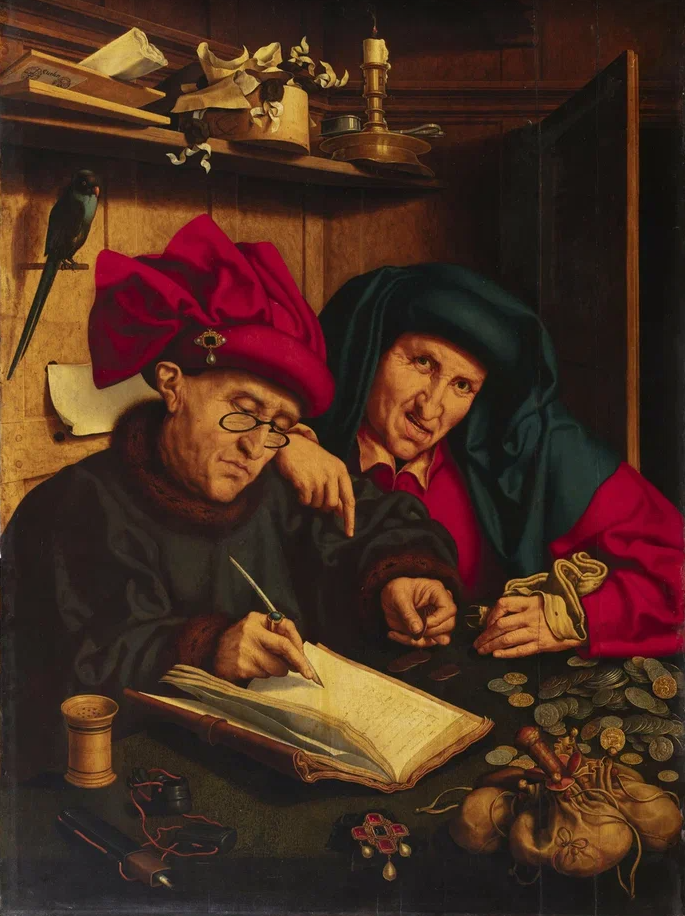Studio of Marinus van Reymerswaele. Tax Collectors. Circa 1550.

Marinus van Roymerswaele was a renowned Dutch painter who produced numerous genre paintings. One of the favorite subjects of the master and his pupils was the work of tax collectors. The composition Tax Collectors is rich in legal themes, primarily connected to the tax system of the medieval Netherlands.
Tax collection in the Netherlands, which at that time was part of the Spanish Habsburg domains, was carried out through an extremely complex system due to the lack of state centralization. The monarch set the total tax amount to be collected, while fiscal policy was implemented by a governor he appointed, who was required to consult with the States General.
This representative authority, composed of nobles and wealthy merchants, had the power to distribute the tax quota set by the monarch among the provinces. The tax amount assigned to each province was then allocated among its municipalities and rural districts.
During this period, the Netherlands operated under a tax farming system (Dutch belastingpacht). This meant that tax collection rights were purchased at auction and formalized through a tax farming contract. Such contracts were temporary, valid for periods ranging from three months to one year. A private individual who could pay the required tax sum upfront acquired the right to collect taxes within a specified area, such as a particular municipality. Tax collectors were legally permitted to collect above the government-mandated rates to generate profit, which also covered their expenses for acquiring the collection rights.
The Netherlands was one of the wealthiest possessions of the Habsburg dynasty. From the 16th century onward, it was governed by the Spanish branch of the Habsburgs and contributed 45% of all revenues to the imperial treasury. Due to constant military campaigns by Christian monarchs and the need to defend state borders, there were repeated attempts to impose higher taxes in the Netherlands.
Monetary law represents another legal dimension associated with this painting. The scattered coins minted by various European mints depicted in the artwork illustrate the complexity of the Dutch monetary system.
Monetary authority in the Netherlands was still grounded in the Golden Bull of 1356, issued by Emperor Charles IV of the Holy Roman Empire. Under this decree, princes of the imperial territories were granted the right to mint their own currency. As a result, a variety of coins circulated across the different provinces of the Netherlands. In the central regions, locally minted silver coins known as stuivers were commonly used; these were initially produced in Antwerp and, from the late 14th century onward, also in Amsterdam. In the northern provinces, stuivers (NLD) were rarely struck, and northern German coins dominated circulation, while in the southern provinces, Flemish coinage prevailed.
The introduction of gold coins followed the Crusades and the subsequent influx of merchants into Europe—who did not value silver.
Certain details in the painting add additional meaning to its primary legal narrative. Notably, the canvas features a favored symbol of Dutch painting - the parrot. Since medieval times, this bird has carried dual symbolism: on one hand, it was considered a witness to the Fall of Man, while on the other, it represented prosperity. The artist likely intended to emphasize both of these connotations in relation to the tax collectors of his era.
Marinus van Roymerswaele, like other renowned Dutch masters, employed specialized brushes in creating his paintings - the same types still used by artists today. Specifically, these were squirrel-hair brushes and bristle brushes. Squirrel-hair brushes were crafted from the animal's tail hairs, prized for their softness and elastic texture. Round or flat bristle brushes were made from hog hair. These brushes proved particularly suitable for oil painting: their uncleft tips excelled at retaining paint.